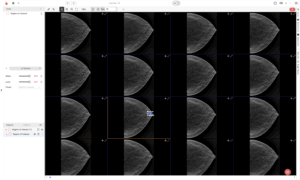If you are building AI for radiology, diagnostic imaging, or digital pathology, selecting the right medical annotation solution is critical. From browser-based 3D annotation tools to expert workforce-enabled workflows, today’s leading tools and service providers vary widely in capability.
Here is a breakdown of the top medical imaging annotation tools and services trusted by MedTech and healthcare AI teams, along with what makes iMerit stand out as the only end-to-end radiology data partner.
This market overview was developed by iMerit using publicly available information and is designed to assist healthcare AI developers and decision-makers in selecting the best radiology annotation tools and services for their projects.
Top Medical Imaging Annotation Tools and Medical Data Labeling Providers in 2025
1. iMerit + Ango Hub
iMerit offers a unique full-stack solution combining Ango Hub’s medical-grade tooling with domain-trained annotation teams, including US board-certified radiologists. Ango’s Radiology Annotation Product Suite supports regulatory-compliant workflows such as HIPAA and 21 CFR Part 11. It delivers 3D multiplanar labeling and specialized use cases across cardiac MRI, breast imaging, maternal-fetal health, and more.
In 2025, Ango Hub introduced support for up to 16 simultaneous DICOM images, allowing annotators to review and compare multi-sequence or multi-phase data side by side. This is ideal for functional imaging, temporal comparisons, or radiopharmaceutical studies. It delivers the most advanced radiology annotation workflows with integrated medical data labeling teams.

In 2025, Ango Hub introduced support for up to 16 simultaneous DICOM images, allowing annotators to review and compare multi-sequence or multi-phase data side by side. This is ideal for functional imaging, temporal comparisons, or radiopharmaceutical studies.
- Regulatory-grade workflows
- Hybrid tiered expert workforce
- 3D multiplanar and volume rendering
- Support for DICOM, NRRD, and NIfTI formats
- Support for 16 simultaneous DICOM views
- Integrated model support and quality assurance
This makes iMerit ideal for MedTech teams needing accurate, GxP-aligned data pipelines. It is the only provider with in-house radiologists, regulatory support, and end-to-end project services.
2. V7
V7 offers intuitive tools and auto-labeling for DICOM datasets with support for radiology workflows. It includes multiplanar viewing but does not provide multi-series or high-volume parallel image support like iMerit’s 16-view feature. Its platform is user-friendly for AI model training but remains limited for highly specialized clinical workflows.
Features:
- Automated workflows for radiology tasks
- Real-time collaboration features
- Easy-to-use interface for non-technical users
- Supports DICOM annotation
Limitations:
- No in-house medical experts
- No support for 16-image views
- Lacks advanced compliance controls for regulated environments
3. Encord
Popular among research teams and developers, Encord focuses on model-assisted annotation and workflow automation. While it supports DICOM and NIfTI formats, it lacks advanced visualization and multi-image synchronization features. It is better suited for experimental pipelines than enterprise-grade radiology workflows.
Features:
- Strong model integration and automation
- Customizable workflows for developers
- Flexible API for integration with ML pipelines
Limitations:
- No expert workforce
- No multi-view features
- Limited regulatory and compliance support
4. Datature
Datature is built for experimentation with machine learning models. While it supports medical imaging formats, it is not optimized for complex radiology tasks and lacks both regulatory compliance and multi-image support. It’s well-suited for startups testing prototypes, but falls short for enterprise radiology deployments.
Features:
- Lightweight tooling for quick setup
- API-first design for developers
- Cost-effective for early-stage research teams
Limitations:
- No 3D viewing capabilities
- No simultaneous viewing capabilities
- No compliance support for medical use cases
5. RedBrick AI
RedBrick offers synced scrolling and multi-series uploads. However, it does not match the scale of iMerit’s 16-view capability. Its strength lies in its cloud-based viewer and support for major modalities, making it a good option for teams prioritizing cloud-native workflows. The platform is well-suited for organizations that need FDA-compliant tools for medical imaging but do not require deep customization or integrated expert services.
Features:
- Multi-series upload and navigation
- FDA 510(k) compliant tools
- User-friendly web interface
- Cloud-based infrastructure for easy access
Limitations:
- No expert workforce
- No 16-image grid support
- Limited customization for enterprise needs
6. 3D Slicer and ITK-Snap
These open-source tools are used for image segmentation and visualization in research settings. While they support 3D views, they lack enterprise features, workforce integration, or validation controls needed for clinical-grade AI. They are highly flexible for academic use but not reliable for commercial deployments.
Features:
- Open-source 3D rendering and segmentation
- Wide adoption in research communities
- Strong plugin ecosystem for experimentation
Limitations:
- No annotation services or project support
- Not suitable for large-volume or regulatory workflows
- Steep learning curve for non-technical users
Why Choose iMerit for Radiology AI Annotation in 2025
Building reliable and accurate radiology AI requires more than just annotation tools; it demands clinical expertise, regulatory-grade workflows, and cutting-edge technology working together seamlessly. That is exactly what iMerit delivers.
With iMerit, you get:
- Expert annotation teams, including US board-certified radiologists and domain specialists
- Regulatory-compliant workflows aligned with HIPAA and 21 CFR Part 11 standards
- Advanced support for DICOM, NRRD, and NIfTI formats, multi-sequence and simultaneous viewing of up to 16 DICOM images
- Native 3D multiplanar annotation and volume rendering capabilities
- Smart automation tools combined with rigorous expert quality assurance
- Custom workflows, APIs, and scalable hybrid workforce models tailored to your project
- End-to-end data operations with full transparency, security, and auditability
iMerit + Ango Hub is your all-in-one solution for accelerating AI development in radiology.
If you are building radiology AI and need multi-sequence, multi-view DICOM workflows, domain-trained expert reviewers, HIPAA and CFR compliance, and custom quality assurance with arbitration, iMerit + Ango Hub is your all-in-one solution.
Learn more about how iMerit’s medical annotation services accelerate AI development across radiology.
For enterprises building AI in radiology, pathology, and other medical domains, selecting the right medical imaging annotation tool ensures accuracy, compliance, and scale. With its domain-trained workforce and regulatory-ready workflows, iMerit provides a complete solution for medical data labeling and advanced radiology annotation needs.
Schedule a Demo or Contact Us
Feature Comparison Table
| Feature | iMerit + Ango Hub | V7 | Encord | Datature | RedBrick AI | ITK-Snap | 3D Slicer |
| In-house Expert Services | ✅ | ❌ | ❌ | ❌ | ❌ | ❌ | ❌ |
| Regulatory Support | ✅ | ❌ | ❌ | ❌ | ✅ (510k) | ❌ | ❌ |
| Hybrid and Tiered Workforce | ✅ | ❌ | ❌ | ❌ | ❌ | ❌ | ❌ |
| Support for 16 Simultaneous DICOM Views | ✅ | ❌ | ❌ | ❌ | ❌ | ❌ | ❌ |
| Native 3D Multiplanar Annotation | ✅ | ✅ | ❌ | ❌ | ✅ | ✅ | ✅ |
| DICOM/NIfTI Support | ✅ | ✅ | ❌ | ✅ | ✅ | ✅ | |
| 3D Volume Rendering | ✅ | ❌ | ❌ | ❌ | Partial | ✅ | ✅ |
| Collaboration Tools | ✅ | ✅ | ✅ | ❌ | ✅ | ❌ | ❌ |
| Data Control and Security | ✅ HIPAA, CFR | ✅ | ✅ | ✅ | ✅ | ❌ | ❌ |
| Task and Workforce Management | ✅ | ✅ | ✅ | ✅ | ✅ | ❌ | ❌ |
| Smart Tool Automation | ✅ | ✅ | ❌ | ✅ | ✅ | ❌ | ✅ |
| Custom Workflows | ✅ | ✅ | ✅ | ✅ | ❌ | ❌ | ❌ |
| Model Integration | ✅ | ✅ | ❌ | ✅ | ❌ | ❌ | ✅ |

























